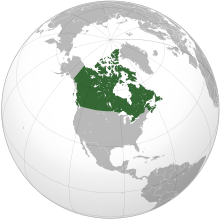Complete ecotouristic information database on national parks of Canada.
Canada is a country in North America consisting of 10 provinces and 3 territories. Located in the northern part of the continent, it extends from the Atlantic to the Pacific and northward into the Arctic Ocean. At 9.98 million square kilometres in total, Canada is the world's second-largest country by total area, and its common border with the United States is the world's longest land border shared by the same two countries (8 891 km).
part of the continent, it extends from the Atlantic to the Pacific and northward into the Arctic Ocean. At 9.98 million square kilometres in total, Canada is the world's second-largest country by total area, and its common border with the United States is the world's longest land border shared by the same two countries (8 891 km).
Canada occupies a major northern portion of North America, sharing land borders with the contiguous United States to the south and the US state of Alaska to the northwest. Greenland is to the northeast, while Saint Pierre and Miquelon is south of Newfoundland. By total area (including its waters). Canada is home to the world's northernmost settlement, Canadian Forces Station Alert, on the northern tip of Ellesmere Island – latitude 82.5°N – which lies 817 kilometres from the North Pole. Much of the Canadian Arctic is covered by ice and permafrost. Canada has the longest coastline in the world, with a total length of 202,080 kilometres.
Since the end of the last glacial period, Canada has consisted of eight distinct forest regions, including extensive boreal forest on the Canadian Shield. Canada has around 31,700 large lakes, more than any other country, containing much of the world's fresh water. There are also fresh-water glaciers in the Canadian Rockies and the Coast Mountains. Canada is geologically active, having many earthquakes and potentially active volcanoes.
Canada's population density, at 3.3 inhabitants per square kilometre, is among the lowest in the world. The most densely populated part of the country is the Quebec City, situated in Southern Quebec and Southern Ontario along the Great Lakes and the St. Lawrence River.
Average winter and summer high temperatures across Canada vary from region to region. Winters can be harsh in many parts of the country, particularly in the interior and Prairie provinces, which experience a continental climate, where daily average temperatures are near −15 °C, but can drop below −40 °C with severe wind chills. In noncoastal regions, snow can cover the ground for almost six months of the year, while in parts of the north snow can persist year-round. Coastal British Columbia has a temperate climate, with a mild and rainy winter. On the east and west coasts, average high temperatures are generally in the low 20s °C, while between the coasts, the average summer high temperature ranges from 25 to 30 °C, with temperatures in some interior locations occasionally exceeding 40 °C.
Detailed information on Canada provinces.
There is a database of Canada provinces and territories national parks available. If you have any question or request you can send it by attached Informative Form.